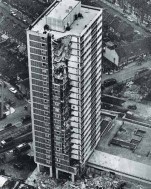Why, How and “What Is Next”?
Calculations for Stability against Progressive Collapse:
Why, How and “What Is Next”?

The vast majority of accidents of buildings and structures regardless of final breakdown aftereffects start with local damages of load-bearing structures. Herewith in some cases everything is ended in original local destructions, and in others – supporting structures, which were saved at the first moment of the accident do not withstand additional loading, which earlier was taken by damaged elements, and also crack. Accidents of the latter type got a name in literature “progressive breaking down”.
This term “progressive collapse” and the formulation of the problem of countering against it (which is understood as a terminological analogue –“vitality” of wall buildings) appeared in 1968 in the report of the committee which was investigating the causes of the famous accident of a 22-storey panel assemblable residential building – Ronan Point in London.
Prevention of progressive collapse is the main principle of building protection in local accidents (LA). It is supposed that no prophylactics or economically proved technical means can totally exclude local destructions of supporting structures of the building at accidental influences which are typical of anthropogenic LA. In these cases the main thing is to prevent the spread of original destructions (progressive collapse) by means of increase of the level of continuity of the constructive system of a building with a view to relocate loading from damaged elements to non-damaged ones.
The main restriction here is the condition of locality of emergency effect; if it is not fulfilled (for example, a purposeful explosion while pulling down a construction, influence of the negative temperature difference while switching off heating in the whole building, regular bad quality of works at mounting, or even a planned terrorist attack), protection against progressive collapse is useless. We need to mention that in the history of highrise buildings the most “resonance” and deeply investigated collapse of New York twin towers WTC, as a result of purposeful hits of heavy passenger aircrafts is certainly progressive due to the a multistage mechanism (a hit – flood and ignition of fuel – loss of carrier capacity of the columns – collapse), but cannot be used as an example of insufficient “fixity to progressive collapse” due to the fact of a significant non-incident and non-locality of LA.
Besides, efficiency of methods of protection depends on a constructive system of the building: progressive collapse can be prevented in a comparatively simple way at the local destruction of the carrier wall of a redbrick or wall building and it is impossible in case of destruction of one of the columns of a frame building of a contact system.
Full content of this issue you can read here
The full version of the article can be read in our printed issue, also you can subscribe to the web-version of the magazine
 Text: ALEXANDER BE OSTOTSKY, Director General of Stadyo R&D, the Head of REC CM MGSU,
Text: ALEXANDER BE OSTOTSKY, Director General of Stadyo R&D, the Head of REC CM MGSU,
Associate member of RAASN, D.Sc. in Engineering, Professor,
ANDREY PAVLOV, research associate of REC CM MGSU, Ph.D. in Engineering Science


